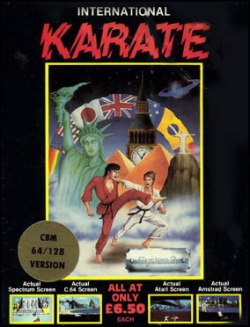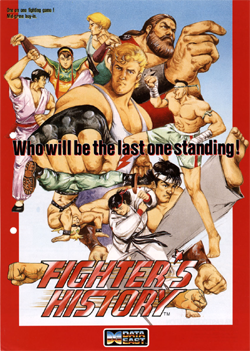
Capcom Co., Ltd. is a Japanese video game company. It has created a number of multi-million-selling game franchises, with its most commercially successful being Resident Evil, Monster Hunter, Street Fighter, Mega Man, Devil May Cry, Dead Rising, Ace Attorney, and Marvel vs. Capcom. Established in 1979, it has become an international enterprise with subsidiaries in East Asia, Europe, and North America.
A fighting game is a genre of video game that involves combat between two or more characters. Fighting game combat often features mechanics such as blocking, grappling, counter-attacking, and chaining attacks together into "combos". Characters generally engage in battle using hand-to-hand combat—often some form of martial arts. The fighting game genre is related to, but distinct from, the beat 'em up genre, which pits large numbers of computer-controlled enemies against one or more player characters.
Clean-room design is the method of copying a design by reverse engineering and then recreating it without infringing any of the copyrights associated with the original design. Clean-room design is useful as a defense against copyright infringement because it relies on independent creation. However, because independent invention is not a defense against patents, clean-room designs typically cannot be used to circumvent patent restrictions.

Epyx, Inc. was a video game developer and publisher active in the late 1970s and 1980s. The company was founded as Automated Simulations by Jim Connelley and Jon Freeman, originally using Epyx as a brand name for action-oriented games before renaming the company to match in 1983. Epyx published a long series of games through the 1980s. The company is currently owned by Bridgestone Multimedia Group Global.

Karate Champ, originally known as Karate Dō, is a fighting game developed by Technōs Japan and released in arcades by Data East in 1984. A variety of moves can be performed using the dual-joystick controls using a best-of-three matches format like later fighting games. The game was commercially successful, especially in the United States where it was the highest-grossing arcade game of 1985 and the best-selling home computer game up until 1989. Karate Champ established and popularized the one-on-one fighting game genre, for which it is considered one of the most influential games of all time.
Apple Computer, Inc. v. Franklin Computer Corp., 714 F.2d 1240, was the first time an appellate level court in the United States held that a computer's BIOS could be protected by copyright. As second impact, this ruling clarified that binary code, the machine readable form of software and firmware, was copyrightable too and not only the human-readable source code form of software.

International Karate is a fighting game developed and published by System 3 for the ZX Spectrum in 1985 and ported to various home computers over the following years. In the United States it was published by Epyx in 1986 as World Karate Championship.

A video game clone is either a video game or a video game console very similar to, or heavily inspired by, a previous popular game or console. Clones are typically made to take financial advantage of the popularity of the cloned game or system, but clones may also result from earnest attempts to create homages or expand on game mechanics from the original game. An additional motivation unique to the medium of games as software with limited compatibility, is the desire to port a simulacrum of a game to platforms that the original is unavailable for or unsatisfactorily implemented on.

The Tetris Company, Inc. (TTC) is the manager and licensor for the Tetris brand to third parties. It is based in Nevada and is owned by Tetris creator Alexey Pajitnov and Henk Rogers. The company is the exclusive licensee of Tetris Holding LLC, the company that owns Tetris rights worldwide.

Stern Electronics Inc. v. Kaufman, 669 F.2d 852, is a legal case in which the United States Court of Appeals Second Circuit held that Omni Video Games violated the copyright and trademark of Scramble, an arcade game marketed by Stern Electronics. The lawsuit was due to a trend of "knock-off" video games in the early 1980s, leading to one of the earliest findings of copyright infringement for a video game, and the first federal appellate court to recognize a video game as a copyrighted audiovisual work.

Midway Manufacturing Co. v. Artic International, Inc., 704 F.2d 1009, was a legal case where the United States Court of Appeals for the Seventh Circuit found that Artic violated Midway's copyright in their arcade games Pac-Man and Galaxian. The lawsuit was part of a trend of "knock-off" video games in the early 1980s, with courts recognizing that a video game can qualify for protection as a copyrighted audiovisual work.
Analytic dissection is a concept in U.S. copyright law analysis of computer software. Analytic dissection is a tool for determining whether a work accused of copyright infringement is substantially similar to a copyright-protected work.

Data East USA, Inc. v. Epyx, Inc. 862 F.2d 204, 9 U.S.P.Q.2d (BNA) 1322 was a court case between two video game manufacturers, where Data East claimed that their copyright in Karate Champ was infringed by World Karate Championship, a game created by Epyx. Data East released Karate Champ in arcades in 1984, and the game became a best-seller and pioneered the fighting game genre. The next year, Epyx published World Karate Championship for home computers, which sold 1.5 million copies. Data East sued Epyx, alleging that the game infringed on their copyright and trademark.
The Ville is a defunct game by Zynga released on June 30, 2012 in which the object was to earn experience points by building a house and talking with neighbors.
The protection of intellectual property (IP) of video games through copyright, patents, and trademarks, shares similar issues with the copyrightability of software as a relatively new area of IP law. The video game industry itself is built on the nature of reusing game concepts from prior games to create new gameplay styles but bounded by illegally direct cloning of existing games, and has made defining intellectual property protections difficult since it is not a fixed medium.

Fighter's History is a 1993 arcade fighting game developed and published by Data East. It's the inaugural game in the Fighter's History series. The main unique feature of the Fighter's History is its weak point system, which allows the player to temporarily stun an opponent by repeatedly hitting their weak point.

Tetris Holding, LLC v. Xio Interactive, Inc., 863 F.Supp.2d 394, was a 2012 American legal case related to copyright of video games, confirming that a game's look and feel can be protected under copyright law. Tetris Holding is a company that holds the copyright to the original Tetris game from 1985 and licenses those rights to game developers. Xio Interactive is a game developer that released Mino in 2009, a mobile game based on the gameplay of Tetris. Mino was downloaded millions of times, and Tetris Holding filed a DMCA notice and eventually a lawsuit against Xio for copyright infringement.

Spry Fox, LLC v. Lolapps, Inc., No. 2:12-cv-00147, was a court case between two video game developers, where Spry Fox alleged that the game Yeti Town, developed by 6waves Lolapps, infringed on their copyrighted game Triple Town. While the case was settled out of court, preliminary opinions by Judge Richard A. Jones affirmed that a video game's "look and feel" may be protected by copyright, affirming the federal district court decision in Tetris Holding, LLC v. Xio Interactive, Inc. from earlier the same year.

Atari, Inc. v. North American Philips Consumer Electronics Corp., 672 F.2d 607, is one of the first legal cases applying copyright law to video games, barring sales of the game K.C. Munchkin! for its similarities to Pac-Man. Atari had licensed the commercially successful arcade game Pac-Man from Namco and Midway, to produce a version for their Atari 2600 console. Around the same time, Philips created Munchkin as a similar maze-chase game, leading Atari to sue them for copyright infringement.

Atari, Inc. v. Amusement World, Inc., 547 F.Supp. 222 is a legal case in which the United States District Court for the District of Maryland held that Amusement World's arcade game Meteors did not violate Atari's copyright in their game Asteroids.














